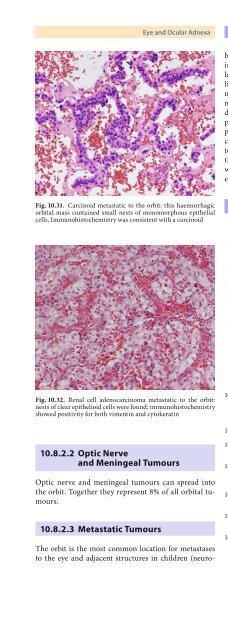Pathology of the Head and Neck
Pathology of the Head and Neck
Pathology of the Head and Neck
- No tags were found...
You also want an ePaper? Increase the reach of your titles
YUMPU automatically turns print PDFs into web optimized ePapers that Google loves.
Eye <strong>and</strong> Ocular Adnexa Chapter 10 307The orbit is <strong>the</strong> most common location for metastasesto <strong>the</strong> eye <strong>and</strong> adjacent structures in children (neuroblastoma),whereas <strong>the</strong> choroid is <strong>the</strong> predominant sitein adults. Approximately 5% <strong>of</strong> all orbital tumour-likelesions are metastatic lesions. However, because malignanciesare far more frequent in adults, most orbitalmetastatic lesions are found in elderly patients. Themean period <strong>of</strong> time between <strong>the</strong> onset <strong>of</strong> <strong>the</strong> primarydisease <strong>and</strong> orbital manifestation is 5 years. The mainprimary symptoms are lid swelling, red eye, diplopia <strong>and</strong>proptosis. The most frequent primary tumour is a breastcarcinoma, but many o<strong>the</strong>r carcinomas can metastasiseto <strong>the</strong> orbit (Figs. 10.31, 10.32). Metastatic melanomas to<strong>the</strong> eye <strong>and</strong> orbit are rare <strong>and</strong> generally occur in patientswith disseminated metastases during <strong>the</strong> terminal stages<strong>of</strong> <strong>the</strong> disease, with a short life expectancy.Fig. 10.31. Carcinoid metastatic to <strong>the</strong> orbit: this haemorrhagicorbital mass contained small nests <strong>of</strong> monomorphous epi<strong>the</strong>lialcells. Immunohistochemistry was consistent with a carcinoidFig. 10.32. Renal cell adenocarcinoma metastatic to <strong>the</strong> orbit:nests <strong>of</strong> clear epi<strong>the</strong>lioid cells were found; immunohistochemistryshowed positivity for both vimentin <strong>and</strong> cytokeratin10.8.2.2 Optic Nerve<strong>and</strong> Meningeal TumoursOptic nerve <strong>and</strong> meningeal tumours can spread into<strong>the</strong> orbit. Toge<strong>the</strong>r <strong>the</strong>y represent 8% <strong>of</strong> all orbital tumours.10.8.2.3 Metastatic TumoursReferences1. Akpek EK, Polcharoen W, Chan R, Foster CS (1999) Ocularsurface neoplasia masquerading as chronic blepharoconjunctivitis.Cornea 18:282–2882. Akpek EK, Polcharoen W, Ferry JA, Foster CS (1999) Conjunctivallymphoma masquerading as chronic conjunctivitis.Ophthalmology 106:757–7603. Armstrong NT (1992) The ocular manifestations <strong>of</strong> congenitalrubella syndrome. Insight 17:14–164. Aultbrinker EA, Starr MB, Donnenfeld ED (1988) Linear IgAdisease. The ocular manifestations. Ophthalmology 95:340–3435. Balayre S, Gomez K, Tribut A, Dore P, Gobert F (2003) Toxoplasmagondii <strong>and</strong> necrotizing retinitis: a case report. J FrOphtalmol 26:837–8416. Bastiaensen LA, Verpalen MC, Pijpers PM, Sprong AC (1985)Conjunctival sarcoidosis. Doc Ophthalmol 59:5–97. Biggs SL, Font RL (1977) Oncocytic lesions <strong>of</strong> <strong>the</strong> caruncle<strong>and</strong> o<strong>the</strong>r ocular adnexa. Arch Ophthalmol 95:474–4788. Bost M, Mouillon M, Romanet JP, Deiber M, Navoni F (1985)Congenital glaucoma <strong>and</strong> Von Recklinghausen’s disease. Pediatrie40:207–2129. Bourcier T, Monin C, Baudrimont M, Larricart P, Borderie V,Laroche L (2003) Conjunctival inclusion cyst following parsplana vitrectomy. Arch Ophthalmol 121:106710. Breslow NE, Norris R, Norkool PA, Kang T, Beckwith JB,Perlman EJ, Ritchey ML, Green DM, Nichols KE (2003)Characteristics <strong>and</strong> outcomes <strong>of</strong> children with <strong>the</strong> Wilms tumor-Aniridiasyndrome: a report from <strong>the</strong> National WilmsTumor Study Group. J Clin Oncol 21:4579–458511. Bruna F (1954) Association <strong>of</strong> keratoconus with retinitis pigmentosa.Boll Ocul 33:145–15712. Busbee BG (2004) Advances in knowledge <strong>and</strong> treatment: anupdate on endophthalmitis. Curr Opin Ophthalmol 15:232–23713. Cervantes G, Rodriguez AA Jr, Leal AG (2002) Squamouscell carcinoma <strong>of</strong> <strong>the</strong> conjunctiva: clinicopathological featuresin 287 cases. Can J Ophthalmol 37:14–19; discussion19–2014. Ceuterick C, Martin JJ (1984) Diagnostic role <strong>of</strong> skin or conjunctivalbiopsies in neurological disorders. An update. JNeurol Sci 65:179–19115. Chai F, Coates H (2003) Otolaryngological manifestations<strong>of</strong> ligneous conjunctivitis. Int J Pediatr Otorhinolaryngol67:189–19416. Chan CC, BenEzra D, Hsu SM, Palestine AG, NussenblattRB (1985) Granulomas in sympa<strong>the</strong>tic ophthalmia <strong>and</strong> sarcoidosis.Immunohistochemical study. Arch Ophthalmol103:198–202








